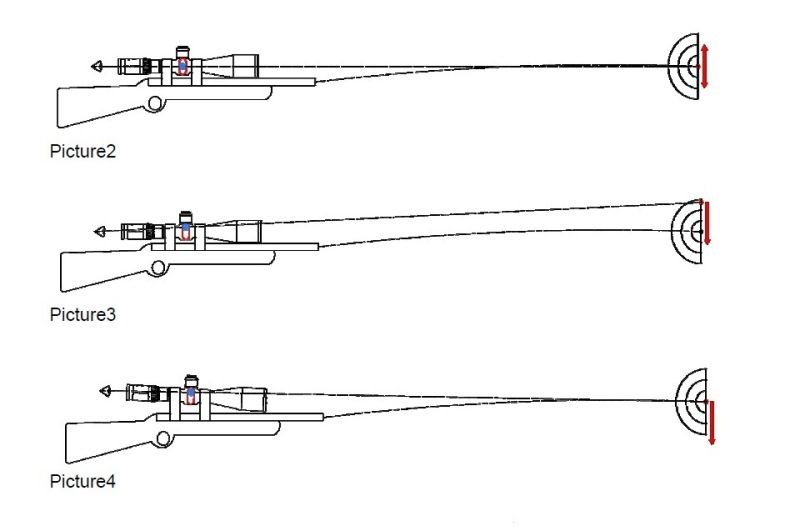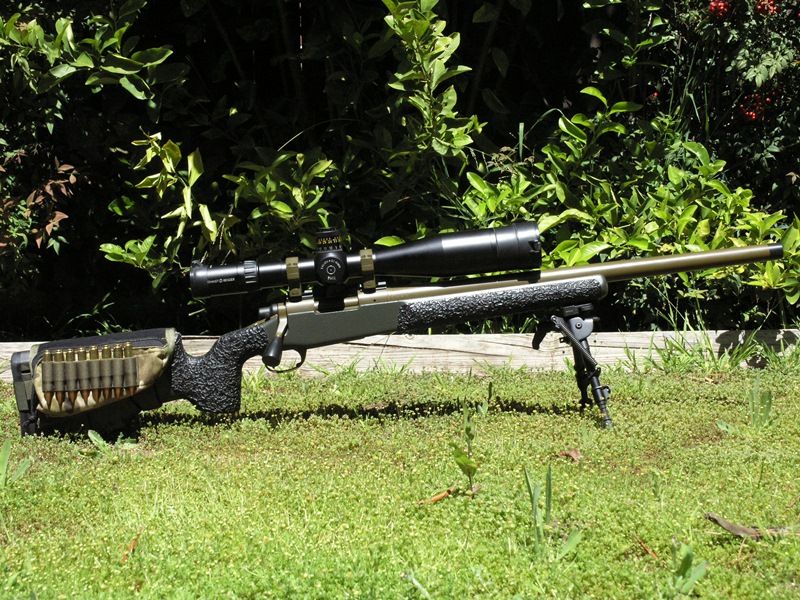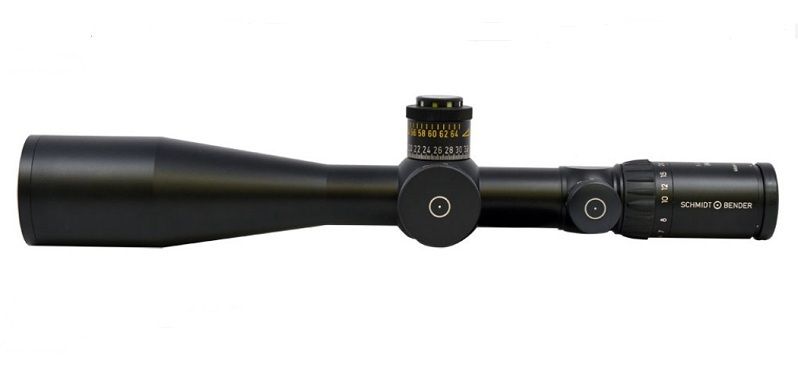Re: S&B question on zeroing and max elevation...
<div class="ubbcode-block"><div class="ubbcode-header">Originally Posted By: cali_tz</div><div class="ubbcode-body">Thanks LL... the docs seemed to suggest it was designed for a 20MOA base, but a 45 would make more sense for my 338LM, otherwise a 20MOA scope leaves this thing topped out at 1600 yards at best.</div></div>
<span style="font-weight: bold"><span style="font-style: italic">cali_tz</span></span>: You need to read the documentation more carefully - <span style="font-weight: bold">PMIIs' are designed and engineered to be used with aggressively canted bases. PMII variables' are preset at the S & B factory with their reticles' adjusted out-of-center by HALF of their FULL Elevation travel, giving them UPWARD Elevation bias. In order to compensate for this mechanical bias/offset, a base that approximates one half of each respective scope's full Elevation travel should be used.</span> <span style="font-weight: bold"><span style="font-style: italic">(Which, for a non-Locking Turret .25 MOA PMII 5-25X is 65 MOA)</span>.</span> <span style="font-style: italic">Theorietically</span>, you want a 32.5 MOA base. However, its' a good idea to get a base with a few "extra" MOA built-in to allow for the 5-7 MOA you'll probably use to zero at 100 yards. Now you're at a 38-40 MOA base. The 0.1 MIL version of the PMII 5-25X was originally designed to be used on a 45 MOA base and the .338 LM. You should also be able to use a 45 MOA base as well. Schmidt Bender only developed the .25 MOA version under pressure from the U.S..
Selection of a base with the correct cant is all detailed in the <span style="font-weight: bold"><span style="font-style: italic">"
2006 PMII User Manual"</span></span> beginning on page 3 under <span style="font-weight: bold"><span style="font-style: italic">"Section 4.2"</span></span>, <span style="font-weight: bold"><span style="font-style: italic">"Adjustment range and forward angle"</span></span> and concluding on page 4. Italicized and in quotation marks below is the section I am speaking of. Below the text of Section 4.2 is a diagram from page 19 of the PMII User Manual showing <span style="font-style: italic">"picture 2"</span>, <span style="font-style: italic">"picture 3"</span>, and <span style="font-style: italic">"picture 4"</span> as referenced in the (2006) User Manual. Keep in mind that the Manual does not allow for any travel used to "zero" the scope as I did in my paragraph above.
<span style="font-weight: bold"><span style="font-style: italic">"4.2. Adjustment range and forward angle
Scopes for high precision shooting are often used for shooting at great
distances. In this case the elevation adjustment is used to compensate for bullet
drop. To provide an extensive elevation range in these scopes Schmidt &
Bender has increased the main tube diameter from 30mm to 34mm.
Nevertheless the elevation and windage range like in any other scope is limited.
In scopes for hunting the reticle is generally centered optically and mechanically
in order to receive the same amount of travel in all directions and to make the
mounting of the scope to the firearm easier (see picture 2).
In order to make the elevation adjustment range usable in its full extent it is
necessary to preset the reticle of the PMII scopes out of the center already at
the Schmidt & Bender factory (see picture 3). As a consequence the gunsmith
is obliged to consider the preset position of the reticle in the elevation range
when mounting the scope to the firearm (see picture 4). With this setup the full
elevation range is usable in one direction allowing to shoot at distances up to
2000m depending on the used calibre and scope type.
Determining the correct forward angle
The necessary forward angle is depending on the used type of elevation
adjustment. At the Schmidt & Bender factory the reticles of PMII scopes are
adjusted out of center by half the amount of the full elevation range. This value
must be compensated in the mount system.
Forward angled mounts or rails for every Schmidt & Bender PMII scope type
are available from all renowned mount manufacturers.
Example for determining the required forward angle:
A standard elevation turret (Single Turn) with an elevation range of 13mrad
(equals 130cm at 100m distance) requires a forward angle of 65cm at 100m
(equalling the half of the full elevation range). For a gunsmith compensating for
this value using the mounts the following rule of thumb applies: If the space
between the two mount rings is 100mm the front mount should be 0.65mm
lower than the rear mount.
If the gunsmith is using a forward angled rail standard mount rings without
forward angled can be used."</span></span>
<span style="font-weight: bold"><span style="font-style: italic">"picture 2"</span>, <span style="font-style: italic">"picture 3"</span>, and <span style="font-style: italic">"picture 4"</span> as referenced in the <span style="font-style: italic">2006 PMII User Manual:</span></span>
I hope this post clears-up any confusion members may have about the use of canted bases and the correct base cant for use with PMIIs', as well as to help guide new PMII owners' and would-be PMII owners' towards the selection of the correct base for use with their PMII.
<span style="font-weight: bold"><span style="text-decoration: underline">NOTE:</span></span> <span style="font-weight: bold"><span style="font-style: italic">In the diagram above:</span></span>
<span style="font-weight: bold">"<span style="color: #FF0000">Picture 2</span>"</span> shows a scope mounted on a rifle with a flat (non-canted base). The drawing illustrates a typical scope with optically-centered reticle and erector. Personally, I always use canted bases, as they have no downside - they dont adversely affect 100 yard zeroing and shift a bit of Elevation travel to the upper end of the scope's adjustment range.
<span style="font-weight: bold">"<span style="color: #FF0000">Picture 3</span>"</span> shows a scope mounted on a rifle with a flat (non-canted base). The drawing illustrates the effect that the PMII's Reticle offset (PMII reticle's are preset at the factory <span style="text-decoration: underline">biased towards the top of the scope tube</span>) has upon the PMII's operation and the PMII's requirement for specific cant scope bases. This mechanical offset is engineered into the PMIIs' and requires use of specific cant bases in order to get optimum Elevation travel out of respective PMII scopes. The Reticle's off-center orientation (towards the top of the tube) means that you're actually looking very slightly upward when you look through a PMII at the bottom of it's travel, and that the Reticle's LOS (Line-of-Sight) won't intersect the projectile's trajectory without a lot of "UP" adjustment. Obviously, the scope's offset over the bore will require the shooter to use a lot of "UP" adjustment to zero the rifle. Use of a correct cant base eliminates these issues and allows the PMII to function as designed.
<span style="font-weight: bold">"<span style="color: #FF0000">Picture 4</span>"</span> shows a scope mounted on a rifle with a canted base. The drawing illustrates how the use of a base with the correct cant affects the PMII Reticle's LOS (Line-of-Sight) and allows the respective PMII access to it's full Elevation adjustment range. The Reticle is still oriented at the top of the scope tube, but the canted base has angled the scope (and Reticle) slightly downward in relation to the axis of the bore, allowing the Reticle's LOS (Line-of-Sight) to intersect with the projectile's trajectory. The scope can now be "zeroed" with minimal Elevation adjustment. After the scope is zeroed, the Elevation Turret shoud be set to "0". Scopes with DT (Double Turn) Elevation Turrets should be reset.
Also, the illustrations show the bullets arcing upward from the axis of the bores. This, of course - does not occur in real life. I'm sure that the gravity-defying bullets were drawn in that manner to simulate the arc of the rounds as they travel downrange.
<div class="ubbcode-block"><div class="ubbcode-header">Originally Posted By: cali_tz</div><div class="ubbcode-body">Does anyone know of a 34mm ring set that comes as part of a 20MOA (or so) picatinny mountable assy? The MAK Mil Mount does the trick, but those guys seem permanently offline. </div></div>
I recommend that you use a mount or base that has 40-45 MOA of cant (allowing you to be able to get the most travel out of your scope). Aside from the SPUHR, NEAR Alpha Mount you can also use a one or two-piece base. I use a Tac Ops 40 MOA Two-Piece base on my Tac Ops X-Ray 51, but I may switch over to Tac Ops 45 MOA Two-Piece Base just to squeeze the last bit of Elevation travel out of the scope. Both the 40 and 45 MOA Tac Ops Bases are drilled for 8-40 screws.
<span style="font-weight: bold"><span style="font-style: italic">Tac Ops X-Ray 51 in "Tac Ops OD" with PMII 5-25X 0.1 MIL Gen 2 XR CCW, Tac Ops 40 MOA Two-Piece Base, & Leupold Mark 4 High Rings:</span></span>
Keith





